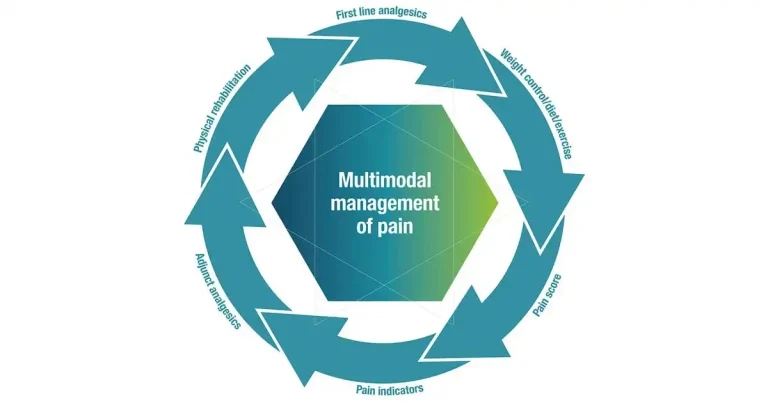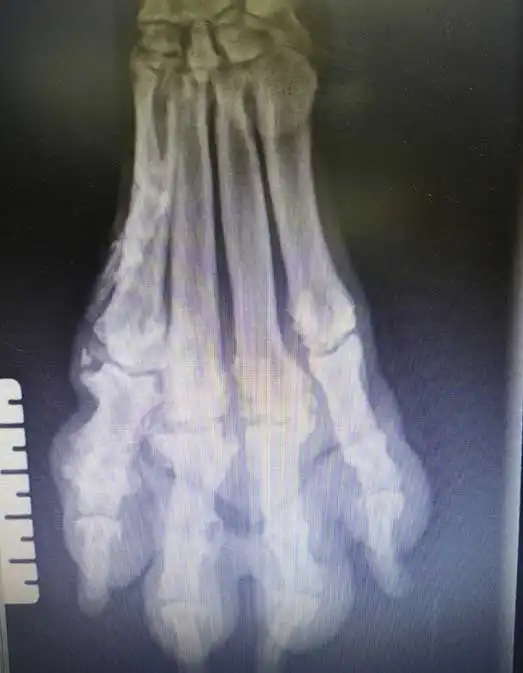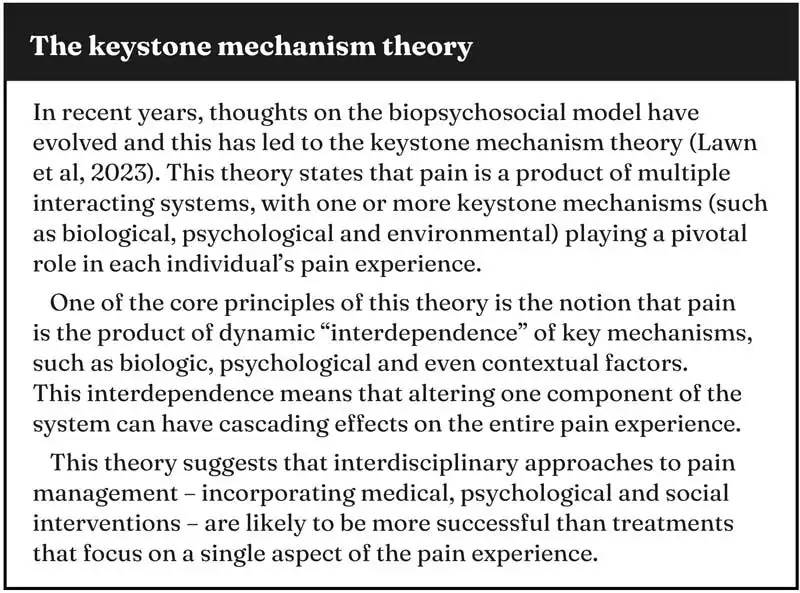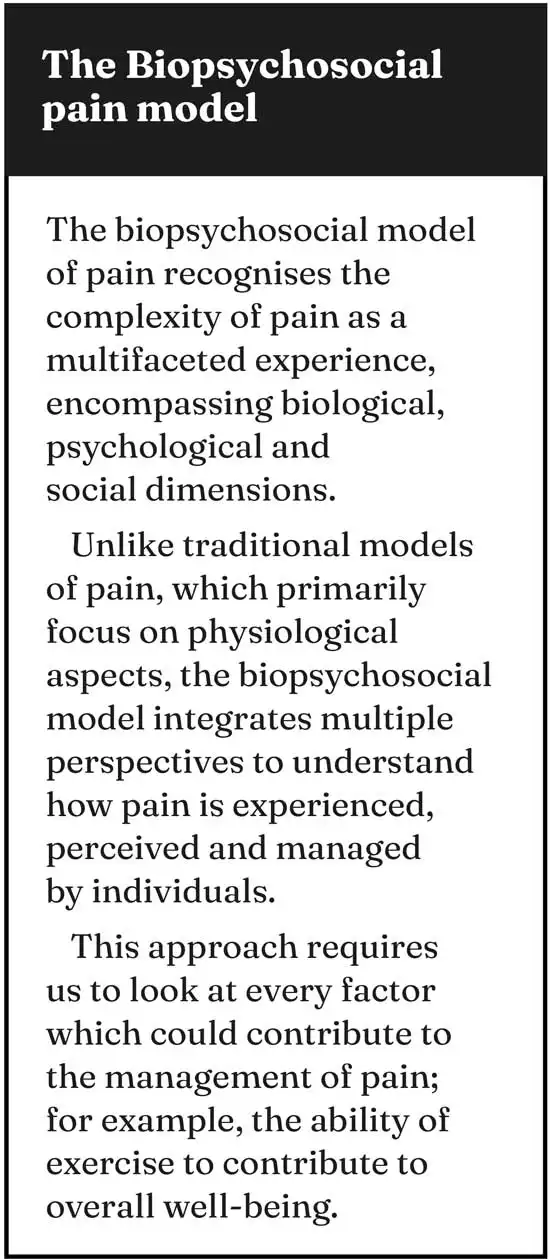8 Jul 2025
Models of pain understanding
Matt Gurney BVSc, CertVA, PgCertVBM, DipECVAA, FRCVS considers the biopsychosocial approach and how vets can work closer with caregivers.

Pain can be managed through a combination of considerations.
In a world where we are all short of time, it’s easy to reach for quick wins to get us through. But when it comes to pain and its management, taking the time to consider the wider factors can make all the difference to our patients.
In this article, we will explore the benefits of the biopsychosocial pain model, a comprehensive framework that incorporates the more complex aspects of pain, and how to utilise this approach in our osteoarthritis (OA) care plans.
We know from the literature that clients value our recommendations in OA care, so, as veterinary professionals, we are well placed to highlight that multiple factors contribute to the overall management plan. Here, we break down those different factors to help you tailor your care plans to best meet the individual case’s needs.
Biological factors in pain
While the biopsychosocial approach encourages us to consider more than just the biological elements, it’s still an important place to start. Making efforts to ensure that our clients have an understanding of the disease process is important, but this should not be where the discussion ends.
There is only so much that clients can take in and meaningfully retain, however, and this leads to a few questions we need to ask ourselves: are we better to give a very brief pathophysiological explanation and then check with the client if they would like more information? Would they prefer us to direct them to further resources and, if so, do we have them readily available? Analgesics form our prime approach to addressing the biological factors and should be coupled with physical therapy. As the biopsychosocial approach suggests, though, other patient-specific and caregiver-specific needs require thought to develop a more complete management plan and ensure the best outcomes for the pet.

Psychological factors in pain
In humans, emotions, thoughts and mental health conditions have been shown to significantly affect how pain is experienced.
Anxiety and depression are commonly associated with chronic pain, often exacerbating the perception of pain and making it more difficult to manage. Similar is true in dogs, and this is recognised in the VetMetrica Health Related Quality of Life instrument, where “happy and content” is listed as one of the behavioural domains. It is something that clients will often mention to us, too, and a good reminder that in the veterinary world, we also have the caregiver to consider; for example, if that person has taken their dog for a run every day for the past five years, and now they can’t, this can have a significant influence on that person’s well-being.
In multi-dog households, there can be an element of guilt if the exercise ability of one dog affects the walks of the other dog and the caregiver struggles for time to do two separate walks.
The interplay between pain and psychological states can result in pain catastrophising. This phenomenon is well documented in humans and leads us to question the influence of the caregiver on how they interpret the pain their pet is experiencing. We know the placebo effect in cats provided with analgesics is high (Gruen et al, 2017) when the outcome measures are reported by the caregiver. Further research is needed on the role of pain catastrophising and how this influences chronic pain scores completed by the caregiver.

Social factors in pain
Social and environmental factors are also integral to the biopsychosocial model of pain. These include cultural beliefs, social support networks and socioeconomic status, all of which can influence how pain is perceived, reported and treated.
Social support plays a vital role in coping with pain. Individuals with strong support networks often experience better pain outcomes, as it can buffer against the negative psychological effects of pain.
Resources from Canine Arthritis Management and International Cat Care, for example, help caregivers feel that they are not alone in caring for a pet with OA, and signposting clients to these organisations is recommended.

Adopting a new approach in practice
An explanation of the biopsychosocial model helps us to understand the well-recognised variability in pain experiences among different individuals. However, it goes without saying that we can’t address all of these factors in one consultation.
Taking some time to create an OA management approach as a practice can help everyone involved. Which aspects of this can be managed in nurse clinics? Are the team all familiar with local rehabilitation practitioners, so they are equipped to make recommendations to caregivers? The Zero Pain Philosophy has a range of educational and support materials to help you and your practice adopt a more comprehensive approach to OA care.
- Article appeared in Vet Times (2025), Volume 55, Issue 27, Pages 12-13
References
- Gruen ME, Dorman DC and Lascelles BDX (2017). Caregiver placebo effect in analgesic clinical trials for cats with naturally occurring degenerative joint disease-associated pain, Veterinary Record 180(19): 473.
- Lawn T, Sendel M, Baron R and Vollert J (2023). Beyond biopsychosocial: the keystone mechanism theory of pain, Brain, Behavior, and Immunity 114: 187-192.
